Ever tried to brew the perfect cup of coffee only to end up with something that tastes completely off? Without precise measurements, even the finest beans and equipment can't save your brew from inconsistency.
A barista scale is a precision weighing device designed specifically for coffee preparation that measures coffee grounds and liquid with accuracy down to 0.1 grams. These scales help baristas maintain consistency in their recipes by providing real-time weight feedback during extraction.

I've been in coffee equipment manufacturing for over a decade, and I can tell you that precision tools transform good coffee into great coffee. From my experience working with top cafés worldwide, scales aren't just accessories—they're fundamental instruments that professional baristas can't work without.
Why Do Professional Baristas Rely on Coffee Scales?
Are you still using scoops or eyeballing your coffee measurements? This guesswork approach is likely why your coffee tastes different each time, leaving you frustrated when trying to recreate that perfect cup.
Professional baristas rely on coffee scales because they provide the precise measurements needed for recipe consistency. By weighing both the coffee grounds (dose) and the final beverage (yield), baristas can maintain the exact coffee-to-water ratio that produces optimal flavor extraction.
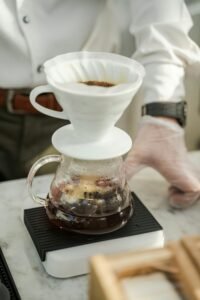
During my visits to specialty coffee shops across Dubai and Europe, I've noticed how the best baristas treat their scales like extensions of themselves. The typical workflow I observe involves precise measurement at multiple stages. For espresso preparation, they typically measure 18 grams of ground coffee as input and aim for 36 grams of liquid espresso as output within 25-30 seconds. This precision is impossible without a reliable scale.
The consistency factor becomes even more critical when dealing with different coffee origins and roast levels. Light roasts and dark roasts have different densities, meaning volume measurements (like scoops) become unreliable. When I trained baristas in Saudi Arabia last year, many were surprised to discover that the same volume of different roasts could vary by several grams in weight, significantly impacting extraction and flavor. Using a scale eliminates these variables, giving businesses the reliability they need when serving hundreds of customers daily.
What Features Make a Quality Barista Scale?
Have you ever wondered why coffee professionals are so particular about their scales? The frustration of delayed readings or water damage can ruin not just the coffee but an entire business operation.
A quality barista scale features high precision (typically 0.1g resolution), fast response time (under 300ms), water resistance, a tare function, built-in timer, and long battery life. These features work together to provide accurate, real-time measurements during the critical moments of coffee extraction.
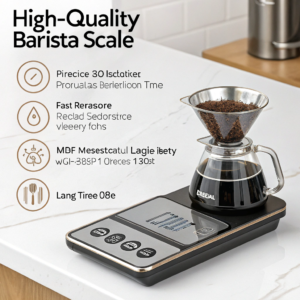
In our manufacturing facility, we've spent years perfecting the balance between functionality and durability in scale design. The most critical components aren't always visible to the naked eye. The load cell—the heart of any digital scale—determines measurement accuracy. We use strain gauge load cells in our premium models, which contain a metal element that changes electrical resistance when weight is applied.
Response time is another crucial factor that separates professional-grade scales from consumer models. When a barista is pulling an espresso shot, even a half-second delay in weight reading can mean the difference between stopping at 36 grams or overshooting to 40+ grams. This is why we calibrate our sensors to respond within 200ms—faster than human reaction time. Water resistance is equally important since coffee preparation involves liquids that can potentially damage electronic components. Our scales undergo rigorous testing where we simulate spills and high-humidity environments to ensure they maintain accuracy even in challenging café conditions.
| Feature | Standard Scale | Professional Barista Scale |
|---|---|---|
| Precision | 1.0g | 0.1g or 0.01g |
| Response Time | 500-1000ms | 200-300ms |
| Water Resistance | None | Splash-proof or better |
| Battery Life | 30-50 hours | 100+ hours |
| Timer Function | No | Yes, integrated |
| Size | Various | Compact, fits on drip tray |
How Are Professional Barista Scales Manufactured?
Ever looked at the price tag of a quality coffee scale and wondered what justifies the cost? The gap between cheap kitchen scales and professional coffee equipment reflects fundamental differences in design philosophy and manufacturing processes.
Professional barista scales are manufactured through a multi-stage process that begins with precision engineering of load cells, continues with circuit board design and calibration, and concludes with rigorous testing under coffee shop conditions. Each unit undergoes individual calibration to ensure accuracy across its entire measurement range.
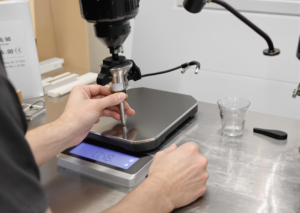
In our factory, I've had the privilege of overseeing the entire production process from start to finish. The journey begins with component selection—particularly the load cell, which is the heart of any scale. For our premium models, we use strain gauge load cells[^1] with temperature compensation features[^2] to maintain accuracy regardless of environmental conditions. These cells contain a precisely machined metal element that deforms microscopically under weight, changing its electrical resistance proportionally to the applied force.
The circuit board design is equally important, as it processes the analog signals from the load cell and converts them into digital readings. Our engineering team spends months refining algorithms that filter out vibrations and environmental interference while maintaining rapid response times. The housing is typically injection-molded using high-grade ABS plastic with silicone seals for water resistance. For our most premium scales, we use 304-grade stainless steel components not just for durability but also for weight consistency during calibration.
Every scale undergoes a three-stage quality control process[^3]. First, we test basic functionality and accuracy using certified calibration weights. Second, we perform stress tests including rapid temperature changes and humidity exposure. Finally, we simulate actual coffee preparation workflows including taring, measuring grounds, and monitoring extraction in real-time. Only units that pass all three stages receive final certification before packaging. This meticulous attention to detail is why professional scales can maintain accuracy within 0.1g over thousands of measurement cycles.
What Materials Are Used in Premium Coffee Scales?
Are you concerned about durability when investing in coffee equipment? In busy café environments, equipment failure means lost revenue and disappointed customers—a risk no business owner wants to take.
Premium coffee scales use materials like aircraft-grade aluminum, tempered glass, stainless steel, and high-density ABS plastic. These materials are selected specifically for their durability, weight stability, and resistance to environmental factors like moisture, heat, and chemical exposure from coffee acids.
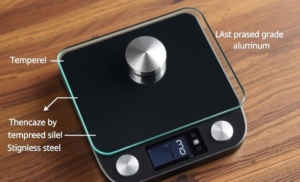
During my years developing coffee tools, I've experimented with countless material combinations to find the perfect balance between functionality, durability, and cost-effectiveness. The weighing platform—the surface where coffee and vessels are placed—requires special consideration. While tempered glass offers an attractive, easy-to-clean surface, it's more susceptible to breakage. Aluminum platforms provide excellent durability but can be affected by temperature changes. Stainless steel, particularly 304-grade, offers the best overall performance for commercial environments.
Internal components demand equally careful selection. The load cell housing must maintain dimensional stability under varying conditions, which is why we use glass-reinforced polymers rather than standard plastics. These materials resist warping from heat and humidity—common issues in busy cafés where espresso machines generate constant steam. Button interfaces typically use silicone overlays with tactile feedback mechanisms beneath, allowing baristas to operate the scale even with wet fingers or while wearing gloves.
For battery compartments, we implement waterproof seals and corrosion-resistant contacts. This might seem like a minor detail, but I've seen many otherwise good scales fail prematurely due to battery compartment corrosion. The feet of the scale also play a crucial role—they need to provide stability while absorbing minor vibrations from espresso machines and grinders. We use specialized silicone compounds with shore hardness ratings specifically calibrated for café environments.
How to Choose the Right Barista Scale for Your Coffee Business?
Do you find yourself overwhelmed by the variety of coffee scales on the market? Making the wrong choice can lead to wasted investment and operational inefficiencies that affect your bottom line.
The right barista scale for your business depends on your specific workflow needs, including precision requirements, space constraints, and durability demands. For espresso-focused operations, choose scales with fast response times (under 250ms) and compact footprints that fit on drip trays, while pour-over specialists should prioritize timer functions and larger platforms.
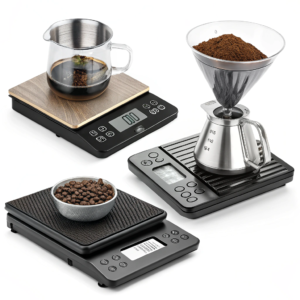
When consulting with coffee businesses across the Middle East, I always start by analyzing their specific workflow before recommending equipment. The volume of coffees served daily dramatically impacts the durability requirements of your scale. A café serving 500+ coffees daily needs industrial-grade components that can withstand constant use, while a boutique operation might prioritize additional features over extreme durability.
Budget considerations should focus on total cost of ownership rather than initial purchase price. I've witnessed countless businesses purchase cheaper scales only to replace them every few months due to failure. Premium scales from established manufacturers typically include warranty protection and offer significantly longer operational lifespans, making them more economical in the long run despite higher upfront costs.
For businesses with multiple brewing methods, consider whether you need separate scales for different stations or a versatile model that works across applications. Espresso scales need to fit on drip trays (typically requiring dimensions under 12cm × 12cm) and provide fast readings for shot timing. Pour-over stations benefit from scales with larger platforms and integrated timers for monitoring brew phases. Some advanced models now offer Bluetooth connectivity and app integration for recording recipes and ensuring consistency across multiple baristas—particularly valuable for businesses with multiple locations or high staff turnover.
| Business Type | Recommended Scale Features | Typical Investment Range |
|---|---|---|
| High-volume Espresso Bar | Ultra-fast response, compact size, water-resistant | $150-300 |
| Specialty Pour-over Café | Integrated timer, larger platform, 0.1g precision | $100-200 |
| Multi-purpose Coffee Shop | Dual display, customizable modes, bluetooth connectivity | $200-350 |
| Mobile Coffee Business | Battery longevity, durability, compact size | $150-250 |
Conclusion
A quality barista scale is the cornerstone of consistent coffee preparation, manufactured through precise engineering with durable materials. Whether you're pulling espresso or brewing pour-overs, the right scale transforms guesswork into repeatable excellence.
---
[^1]: Understanding strain gauge load cells is crucial for anyone interested in precision measurement technology. Explore this link to deepen your knowledge.
[^2]: Temperature compensation features are vital for maintaining accuracy in varying conditions. Learn more about their importance and application here.
[^3]: A robust quality control process ensures product reliability and customer satisfaction. Discover best practices in this informative resource.



